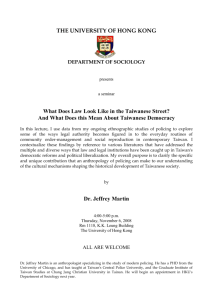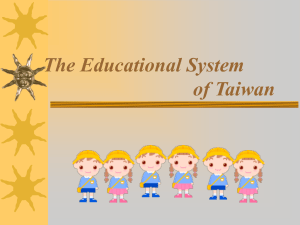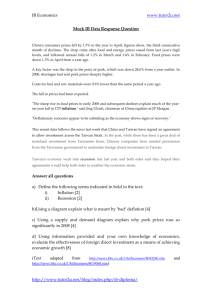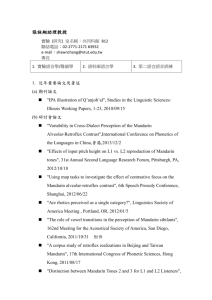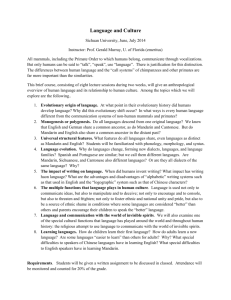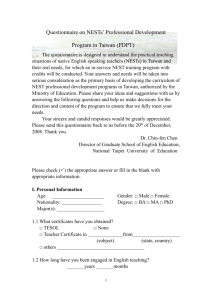codeswitching_and_CMC_language_use
advertisement
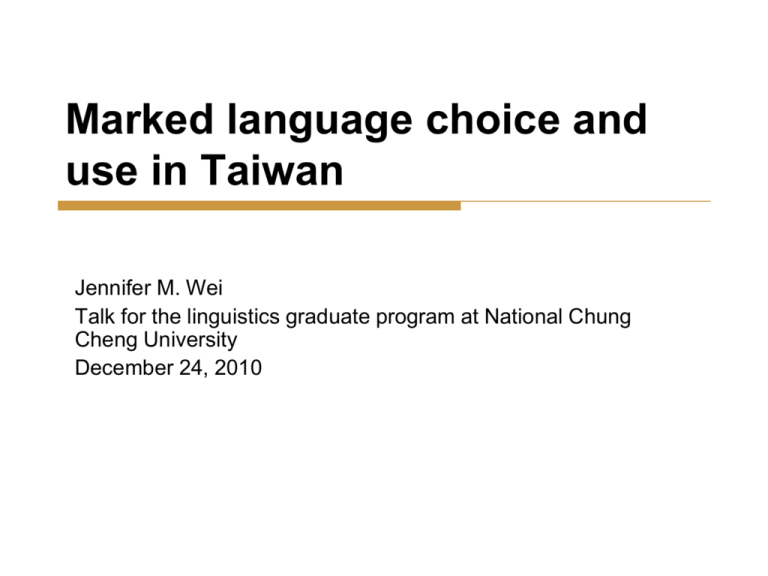
Marked language choice and use in Taiwan Jennifer M. Wei Talk for the linguistics graduate program at National Chung Cheng University December 24, 2010 Objectives for this talk There are two objectives for this talk: to encourage awareness of some of the less common language choices and uses occurring in Taiwan both in public and in Computer Mediated Communication (CMC) venues such as Facebook; to find ways to account for such marked language uses and choices, for those interested in language variation and discourse analysis. Outline of this talk Introduce common language choices and uses in Taiwan and Taiwan’s language policies. Analyze examples by citing theoretical works on codeswitching and markedness and suggesting that Taiwan’s language policies and their legacies can explain some less common but nevertheless mundane metaphorical usage. Provide two examples of metaphorical language use and apply them to a related phenomenon, the stylizing of English, Taiwanese-accented Mandarin, or Taiwanese in Computer-mediated Communication (CMC), using examples from Facebook. What do these examples tell us about writing/speaking Chinese/Taiwanese? Are they really for play and humor or do they reinforce stereotypes? Examples from the media, and how to account for these? Marked language use? Mock language use? Or language play in a postcolonial context? Considerations from current mock Spanish in the USA , and language play in earlier writers such as Taiwan’s 王禎和 in 玫瑰玫瑰我愛你 Common language scenes in Taiwan in the 21st century: The multilingual and codeswitching situation In present day Taiwan, common language choices and uses consist of Mandarin in public and for most official purposes, with English and Japanese taught the most as foreign languages and used in trade, and Taiwanese, Hakka and other Chinese varieties such as Wu and Yue used to a lesser extent at home or other private settings. Most people use more than one language in most of their daily interactions, though they might not do so with equal fluency. That is to say, people constantly switch among English, Mandarin, Japanese, and Taiwanese as situations demand. This is what’s being referred to as “codeswitching” in the sociolinguistic literature. What is codeswitching? Speakers use more than one language in a discourse unit (an exchange, a sentence, a paragraph). “Language” here is defined loosely -- it can be two different languages such as French and German, or varieties of a language family such as Mandarin and Cantonese, or a variety of language styles (such as a mix of different registers). A related but different term, code mixing, refers to hybridization in a shorter and fixed exchange, rather than an active movement from one language to another in a discourse. Code mixing suggests that the speaker is mixing codes indiscriminately, perhaps because of incompetence, whereas code switching refers to a more active manipulation of the symbolic and social meanings of a language choice. Examples of situational codeswitching An example from Singaporean English http://www.youtube.com/watch?v=aoZIF59Qsiw&NR=1 Examples of code switching from pop commercials in Taiwan (switching between Mandarin and Taiwanese) http://www.youtube.com/watch?v=kuCuzcTa33s (cough syrup) Shopping channel http://www.youtube.com/watch?v=9ud7WERrDO8 Jiayi How do people switch languages and why? Code switching occurs at any linguistic boundary (sentence initial, sentence final, between words). Speakers actively interject meanings into conversation by adding varieties. In “situational switching," speakers code switch according to factors (topics, situations, participants). Examples: using more formal codes such as English, Japanese or Mandarin to signal professionalism and authority, or switching to a more “intimate” code such as Cantonese, Hakka, or Taiwanese to signal solidarity or group identity. Less commonly, a skillful code switch can operate like a metaphor to enrich communication without any change in the situation (no change of topic, no new participants, no change of scene). This is what is meant by ‘metaphorical’ usage. Responses to codeswitching among college students. Responses from people who switch codes http://www.youtube.com/watch?v=a2LUUL zo5JU Your response? Metaphorical codeswitching (1) An example involving English and Samoan is taken from Holms, 1992, pp. 49-50. (Words originally spoken in Samoan are in CAPITALS; the rest is English.) Alf is 55 and overweight. He is talking to a fellow Samoan at work about his attempt to go on a diet. My doctor told me to go on a diet. She said I was overweight. So I tried. BUT IT WAS SO HARD. I’D KEEP THINKING ABOUT FOOD ALL THE TIME. Even when I was at work. And in bed at night I’D GET DESPERATE. I COULDN’T GET TO SLEEP. SO I’D GET UP AND RAID THE FRIDGE. THEN I’D FEEL GUILTY AND SICK AND WHEN I WOKE UP NEXT DAY I WOULD BE SO DEPRESSED because I had to start the diet all over again. The doctor wasn’t sympathetic. She just shrugged and said.‘Well it’s your funeral!’ Metaphorical codeswitching (2) In the example, the speaker draws on two languages to express ambivalent feelings about the topic he is discussing. There is no exact one-to-one match, but it is possible to see that in general, personal feelings are expressed in Samoan while English is used for referential content such as “My doctor told me to go on a diet.” Samoan expresses shame and embarrassment (“I’d get desperate”, “I would be so depressed”.) Connecting this to theory Rational Choice (RC) or Markedness Model (From Myers-Scotton and Bolonyai, Language in Society 30:1 (2001) p. 23) RC theory is based on an assumption about human cognition: in the parlance of my field, that actors are oriented to seek optimality of an interpersonal nature in their actions, including their linguistic choices. Specifically as a sociolinguistic construct, markedness refers to the capacity to develop the following three abilities. (i) Most important is the perception that relevant linguistic choices for a specific interaction type fall along a multidimensional continuum from more socially unmarked to more marked. (ii) In addition, speakers learn to recognize that the markedness ordering of choices is dynamic; it depends on the specific interaction type, as well as on how the individual interaction develops. (iii) Finally, speakers develop the ability to provide relevant interpretations for all choices, marked as well as unmarked, given the interaction type. An example For example, a choice made by Kristóf, a Hungarian-and-English speaking boy living in the United States. To speak only Hungarian at the dinner table would be an index of what his parents might prefer as the unmarked RO set for family interactions in his home. Under this RO set, children are compliant with their parents’ wishes to keep their ethnicity salient through linguistic means rather than all generations assimilating fully to the dominant culture. If Kristóf switches between Hungarian and English, this might index a somewhat less preferred RO set, from the parents' point of view. Should Kristóf insist on speaking only English at the family dinner table, this move would index a marked RO set from the point of view of family norms. Under such an RO set, Kristóf would be asserting his independence from familial control and possibly even his “defection” to the dominant (American) culture. Connecting this to political discourse: Why and how Taiwan politicians exploit different languages First, some history to explain why Taiwan’s language scene differs from that of other Chinese communities. Twice in a hundred years a non-indigenous tongue was imposed as a “national" language. First came Japanese during the Japanese occupation (1895-1945), and then came Mandarin during the heyday of KMT rule (1945-1987). Modernization in both Japan and China, combined with an island backlash against nationalistic language policies and a rising Taiwanese consciousness, twice inspired Taiwan language reforms, in the 1930s and 1990s. In the most recent case, with ethno-linguistic consciousness surging and democracy gaining, politicians found they could connect to different constituencies by switching between languages. They could slyly address the unspeakable: Taiwan’s ambiguous national status. They could allude to past wrongs suffered under a Mandarin-only language policy and a China-center identity. They could also exploit stereotypical images of a certain speaker and manipulate derisive effects for political gain. Another example Example (Tai-yu in CAPITALS; the rest in Mandarin) Zhonghua renmin gongheguo burang women miaoli li zi-zhen qu, CHIT8-TIUN1 HO2- PAI5 PIAN3-SENG5 A-PIN2-AH BEH4 LIA7KHI3 TAI5, CHIN1 U7 CHHA7 HIA1 CHE7? (Then-President Chen Shui-bian, campaigning in Miaoli, responding to criticism over his choice of an APEC representative. Era News10/27/01) Trans: The PRC (People’s Republic of China) won’t let our Miaoli adviser Li attend [APEC]. A GOOD CARD WAS TURNED INTO ABIAN’S CAPITAL PUNISHMENT. DID IT REALLY MAKE THAT MUCH DIFFERENCE? What is meant? Symbolic acts of identity are seen here Question is asked: Who is really responsible for not sending the right representative to APEC? An explanation from the Rational Choice Model (Bolonyai and Myers-Scotton 2001) Mixing/crossing languages in public using CMC (Computer Mediated Communication) Some observed characteristics of CMC in Taiwan: Internet communication is both public and private. The medium can be both oral and written. It is a hybrid form. The objective for this kind of communication is not always informational but sometimes creative, poetic or polemic. This contradicts the conventional line that Internet usage is for convenience and immediate gratification (i.e., speed). Speakers are not preoccupied with issues such as language proficiency, standardization or authenticity since the Internet and a certain degree of anonymity, i.e. either through use of a nickname or under the cover of the “friends" category of Facebook, allow individuals some leeway to say and write things as they please. This seemingly “democratized” language scene might also temporarily suspend the advantageous resonances of old language ideologies such as “official speak" and “professional speak” associated with English and Mandarin. In CMC contexts, Taiwanese and Taiwanese-accented Mandarin might not appear to be so déclassé. Language devices seem to enjoy equal status; they are used either as sound and/or written symbols for the users to make fun of something or to make a point in an interaction. Commonplace features of language in Facebook and other CMC locales 1. Stylizing English: using Chinese characters, numbers, (phonetic) alphabets to sound out English 1.1 What happened? 1.2 Facebook 1.3 All passed. 1.4 Thank you. 1.5 I am in love song) 1.6 I am in a dilemma 花 黑 噴? 非死不可 嘔趴 3Q 戀愛ing (title of a 進退兩難ing… Stylizing Japanese 2. Stylizing Japanese: using Chinese characters to sound out Japanese, adopting some form of Japanese grammar into Chinese syntax 2.1 Really? 紅豆泥 2.2 Very cute! 卡哇伊 2.3 ??? 再見一碼事 (changing Japanese verb into noun) Stylizing Mandarin 3. Stylizing Mandarin: using phonetic alphabets or Taiwanese-accented Mandarin to sound out Mandarin 3.1 You are welcome. 不客氣 ㄅ ㄎ ㄑ 3.2 This is really funny. 這太好笑ㄌ 3.3 Would you? 好嗎? OKㄇ? Stylizing Taiwanese-accented Mandarin Tapping into the stereotypical phonological features of Taiwanese-accented Mandarin: lack of retroflex: zh, ch, sh, --->z, c, s lack of rounding: u-->I simplification of diphthongs: uo->o substitution of labial-dental: /f/ with /h/ 4.1 4.2 4.3 4.4 Almost gone crazy. I am teachers students 快發瘋了 我是 老師 同學 快花轟惹 偶似 老蘇 同鞋 Stylizing Taiwanese Using English and Chinese characters to sound out Taiwanese 5.1 封鎖台灣的IP~~A驚喔~ (A response to the alleged South Korean blocking of Taiwan IP [Internet Protocol] addresses after the disqualification of female Taiwan athletes in the recent Asian Games, & media aftermath.) 5.2 係金A~EU聖誕大禮送上了~~申根 VISA~BYE BYE~~OH~YAH *^﹏^* (A response to free-visa entry to most European countries for Taiwanese visitors.) Mixing/crossing of languages as found in media: cooperative discourse speech 少年ㄟ 不愛地球 還是個倫嗎? [Taiwanese in boldface, followed by Mandarin] Trans.: Young men, (if) you don’t love the earth, (then) are you (still) human? From FB Bank advertisement ostensibly trying to promote environmental consciousness among youngsters. (富邦 少年發聲網) What is meant? Humor and language play? Professor Su His-yau (2009, 2010) treats the stylizing of Taiwanese-accented Mandarin in online usage as mostly playful or used to mitigate potentially face-threatening situations. Her claims are mostly based on the incongruity of sounds and meanings in the languages adopted by users online, which further creates humor involving different frames of references. A quasi-parallel from mock Spanish Professor Jane Hill has investigated corrupt ways of speaking/representing Spanish in the USA. Most claim that they use “mock Spanish” for fun and to be humorous, but Professor Hill argues that the systematic ways corrupt Spanish is used together with tensions between groups who advocate/oppose the US “English Only” movement has made this discourse a new “racist” one. That is, users are thought to reinforce stereotypical images and language uses by way of making fun or creating humor. A third view: language play in postcolonial context Although we are focusing on CMC at the moment, we need to be reminded that using/mixing/crossing languages to poke fun, to mock, or to satirize doesn’t start /stop with the Internet. Playwrights have long mastered this linguistic skill to create sarcasm and mock socio-political tensions. Examples from 王禎和 玫瑰玫瑰 我愛你 To conclude: revisiting marked/mock language uses and choices in Taiwan In this presentation, we have laid out cases on mixing/crossing languages in both everyday and political interaction as well as in online communication. While most switching between languages falls into the situational switching category, i.e. involving who/where/what/how we are talking about, there’s also metaphorical switching where the choice of a certain language serves as a symbol to provide emotional/meta-discourse reasons. Remember: A skillful politician can tap into Taiwan’s rich linguistic history and codeswitch for political gain. The Internet’s cooperative culture further can make the mixing of languages fun and more sophisticated. While some scholars view this kind of linguistic crossing/mixing as benign, others claim that the humor reinforces stereotypes and stereotypical linguistic practices. And note: More systematic data is needed to sustain either one of these claims. Meanwhile, we should also consider discourse analysis from broader sociohistorical contexts where language policies, ideologies and histories can play very important roles in shaping how we interpret a linguistic practice. Acknowledgements Thanks are due to Professor Victoria Rau, director at the Graduate Institute of National Chung-cheng University for the invitation, and to students at Soochow University for contributing examples and discussions on this fascinating topic. Thanks also to John Hamilton, Irene Wen and Willis Liao for editorial help and technical support. More to come This lecture was given to the graduate program of linguistics at National Chungchen University. A refined version was published at Journal of Taiwan Linguistics http://tjl.nccu.edu.tw/volume11-2/11.2.3.pdf
